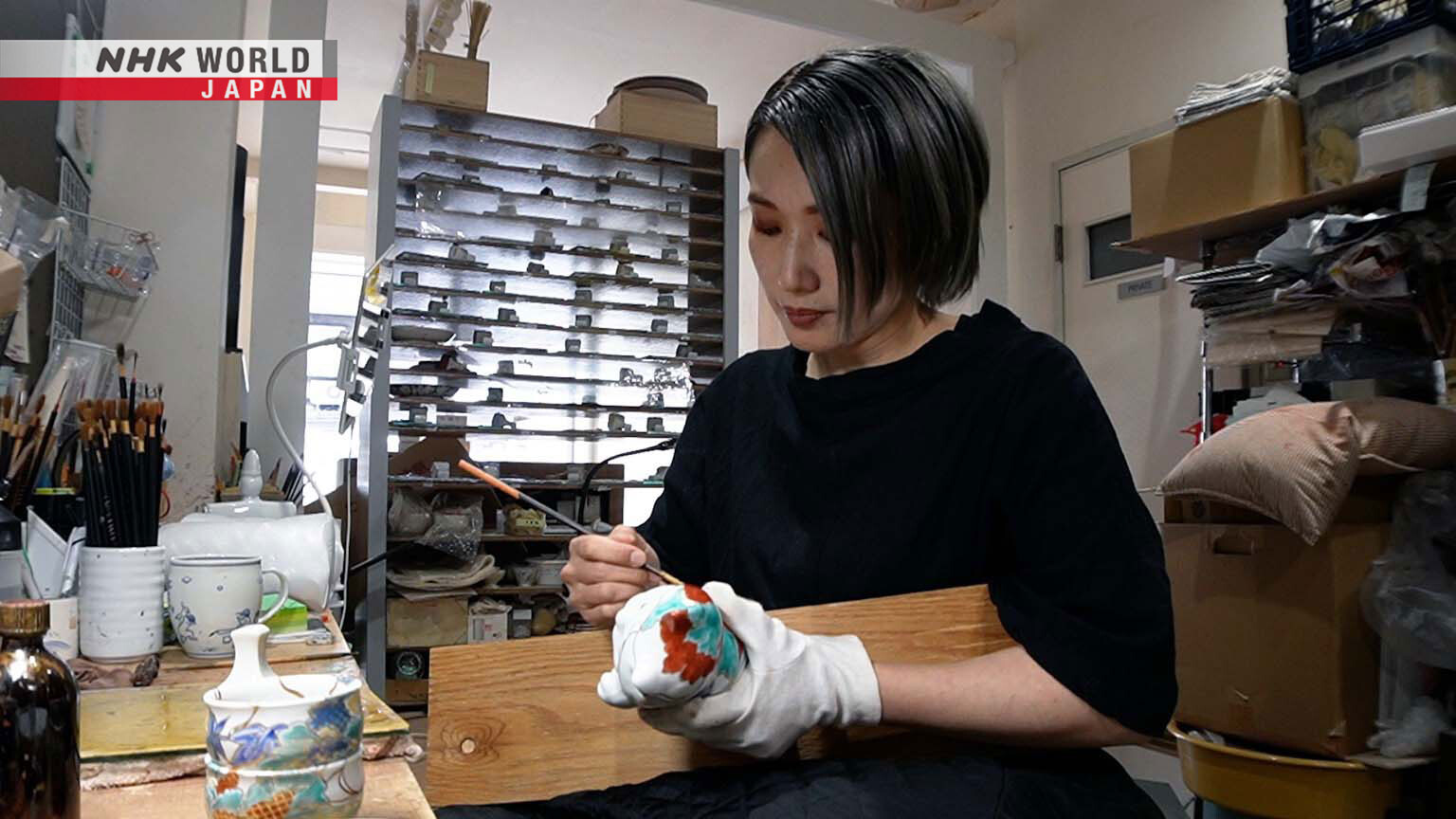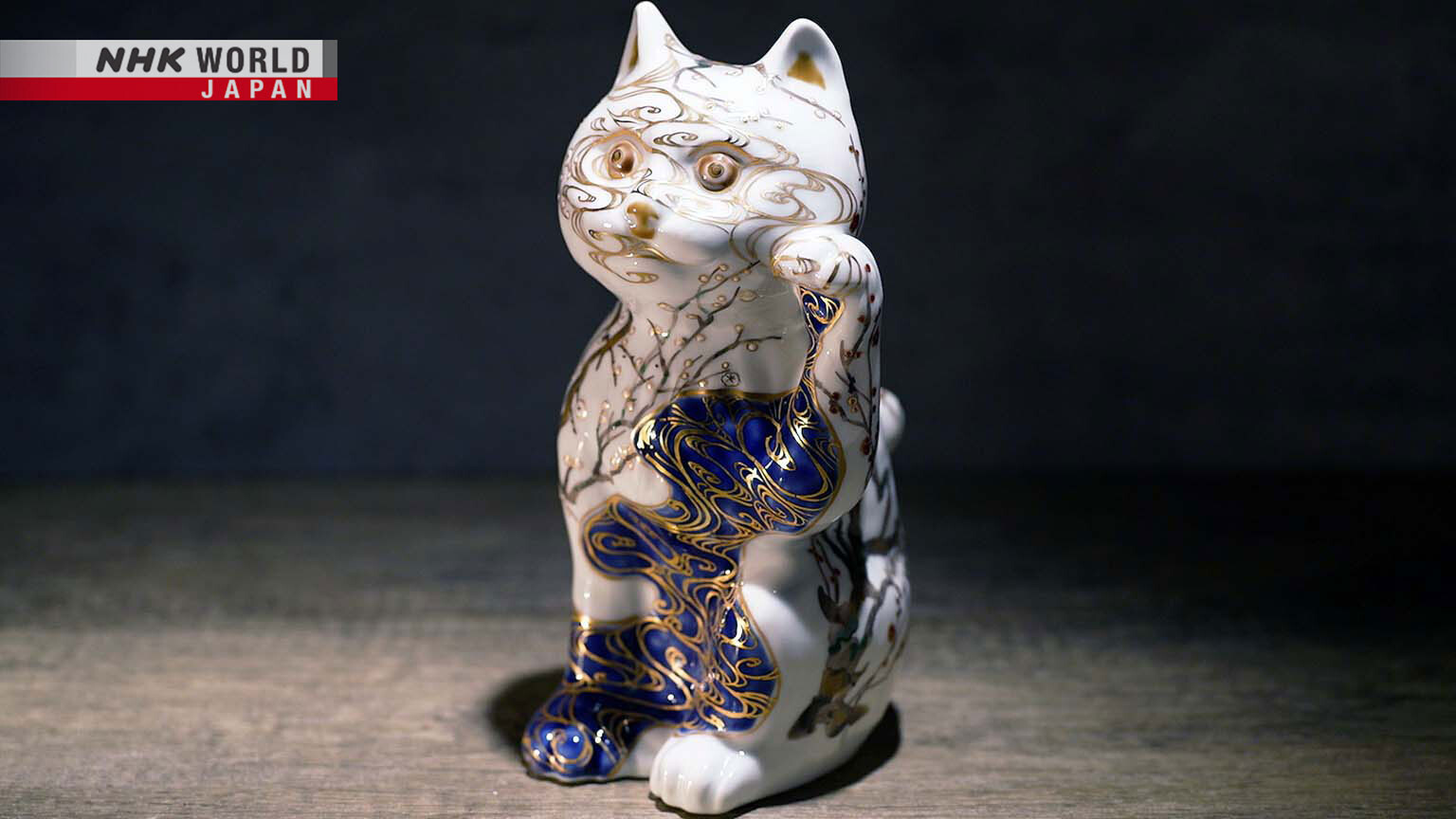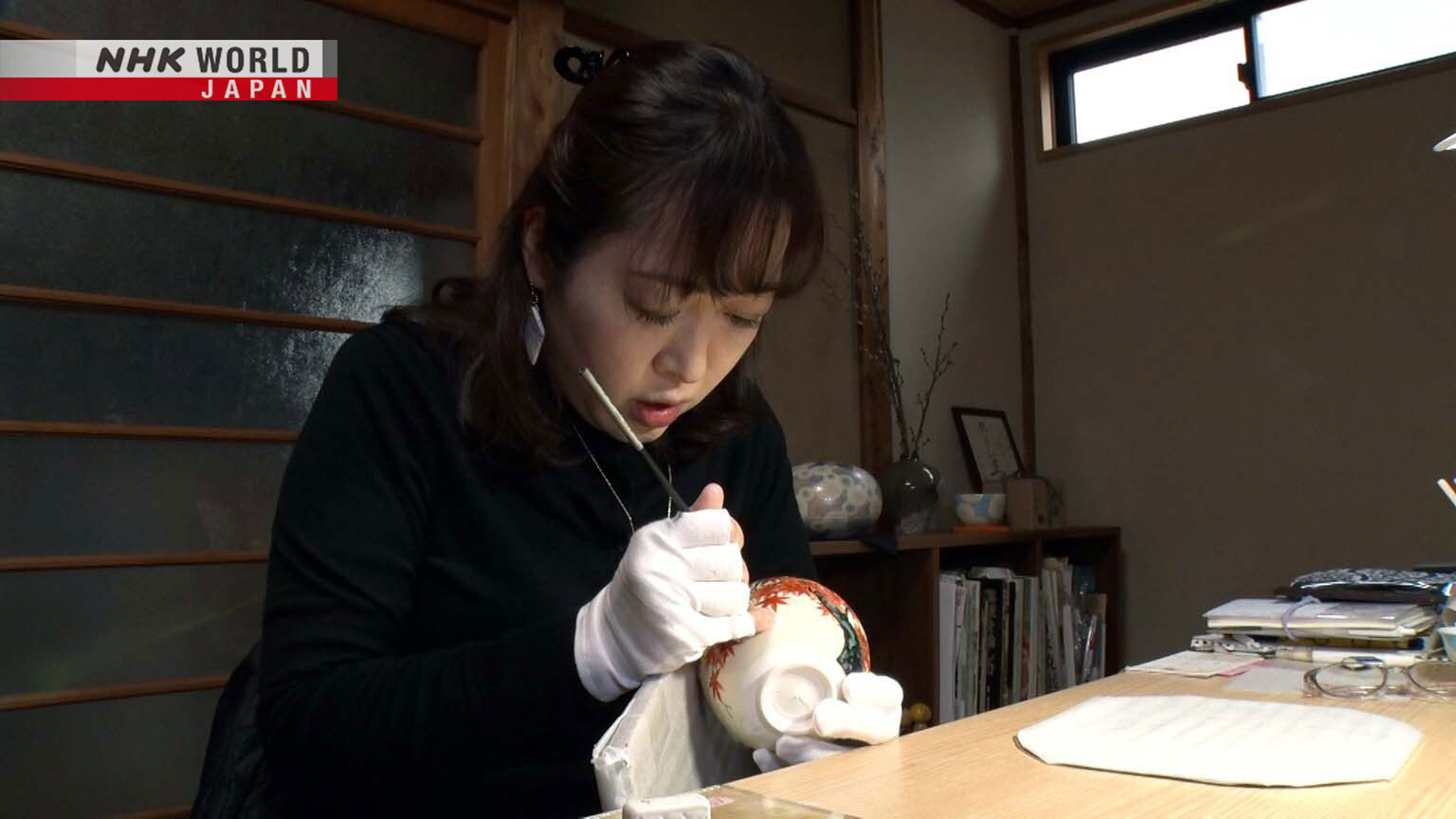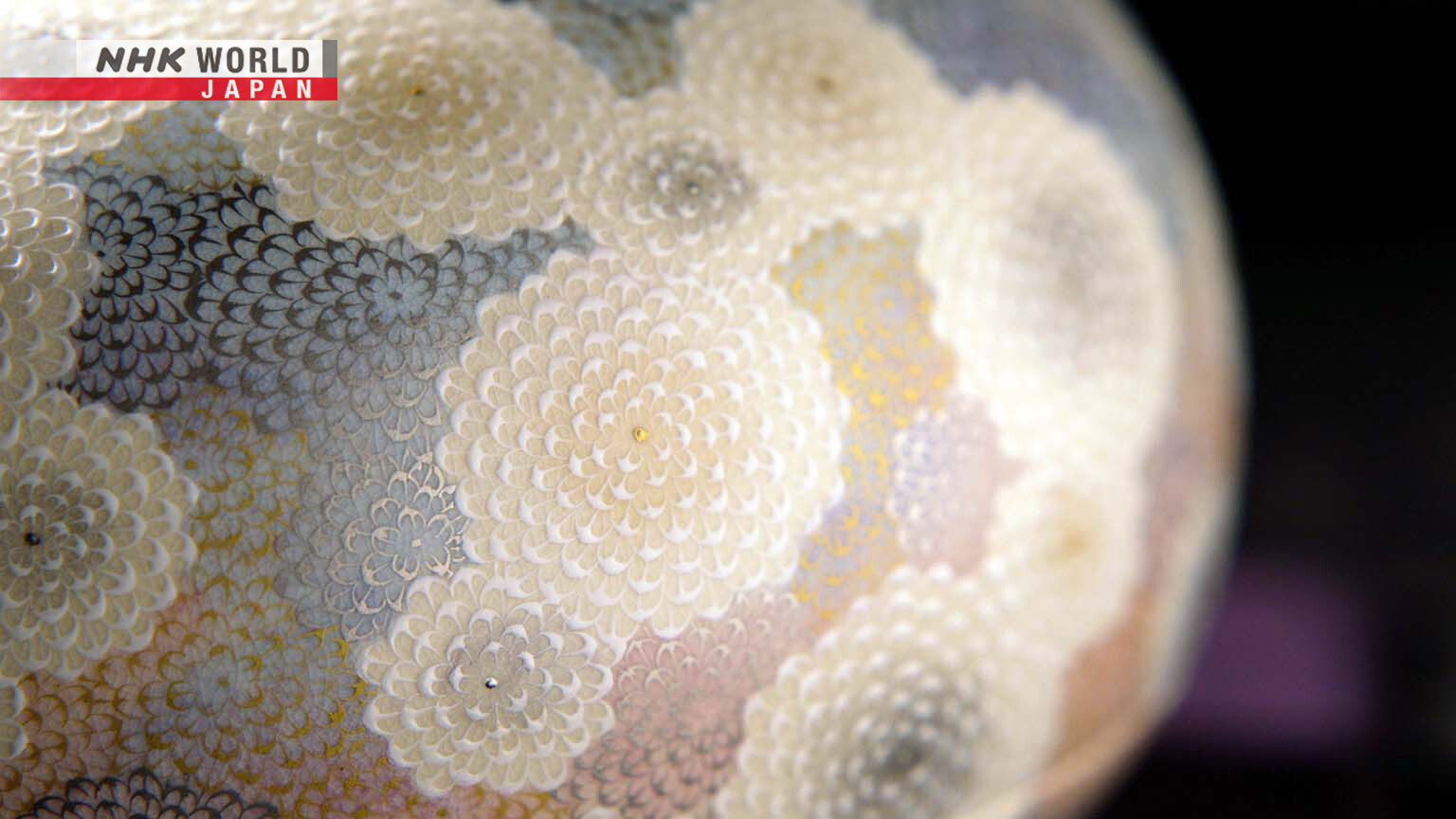Ceramic Painters: A New Perspective to Mastering the Art
Kyoto potters refine their skills in a division of labor. Two painters wield their brushes to create delicate designs in majestic strokes and colors, gaining much attention in the industry and beyond.




Transcript
An artist uses a ceramic vessel as a canvas.
Kyoto ceramics, known as Kyoto ware and Kiyomizu ware, evolved in the 17th century with the development of tea culture.
Generations of potters since have perpetuated the varied and vibrant craft.
Originally, a single potter would throw a piece on a wheel, fire it, and paint it.
But many Kyoto kilns introduced a division of labor after World War II
in response to an increase in domestic and international demand.
Hence, the profession of ceramic painter was born.
Of course I create pieces in the traditional way -
but I aim to make pieces that move people, like music and paintings.
The ceramics industry was traditionally male-dominated, but women are now breathing new life into the craft.
I put everything into my pieces -
and every day I think how happy I would be to continue working like this.
Core Kyoto focuses on female ceramic painters who are redefining the possibilities of the art.
This gallery which doubles as a workshop is situated in Kyoto's Higashiyama area.
The pieces lining the shelves bear a colorful variety of traditional and contemporary designs.
Mitsutake Miyuki, who runs the business, is a highly acclaimed ceramic painter.
I call this the Kamogawa series -
because the designs are inspired by the river's surface and seasonal flowers.
Mitsutake combines a classic water motif with peonies.
She pushes the boundaries, while respecting the traditions of Kiyomizu ware,
which evolved in the area near the Buddhist temple Kiyomizu-dera.
She devotes herself to her profession and raising her two children, whose artwork covers the workshop wall.
In Japan, women who leave their jobs to have a family have difficulty returning to their careers.
Mitsutake's passion for her work led her to buck the system and start her own workshop.
Her designs can be delicate and colorful.
Yet at times they are bold and innovative.
These plates were inspired by an Indian chintz pattern.
Work on each piece begins with preparing the paints.
This is iron. Red is usually made from iron and natural materials.
I crush it finely so it will glide off the brush for a smooth line.
The process is called overglazing.
A plain glaze is applied to the entire piece, which is then fired.
A pattern is painted on the glaze and the piece is re-fired, as necessary.
This cup was overglazed three times.
The gold coloring was applied in the final step.
Kiyomizu ware often uses gold on ceramics used at tea gatherings -
and is a more developed art than other places, so I use gold too.
As the way of tea evolved, artisans from across the country were drawn to Kyoto.
Their skills mingled to produce refined utensils to be used at tea gatherings.
One example is the matcha tea bowl that incorporates a sense of seasonality,
lifting the ambience of the occasion.
Mitsutake regularly practices the way of tea, herself, to understand how the pieces she paints are actually used.
Each time, she makes a new discovery which she can apply to her work.
It teaches me the knowledge and spirituality I crave.
It's an important place for me, because I always return to my workshop energized.
Mitsutake creates numerous series based on motifs.
This is the "maneki-neko," or beckoning cat series.
I focus more on lively designs that ignore the shape.
They show off the possibilities of a pattern, rather than the pattern itself.
Ceramic painters have customarily worked at kilns and remained anonymous.
Mitsutake wanted to change that and went independent to shine the spotlight on the art.
She is now also freer to pursue originality.
The lucky "maneki-neko" is a popular item and she has created many variations.
She is embellishing this one with cherry blossoms in a traditional style that covers the entire surface.
It's time-consuming and requires much patience -
and not many people do it, so I've incorporated this style into my work.
I love the sense of fulfillment I get from steadily filling in the empty space.
It took about 10 days to finish the cat.
This motif is based on an 18th-century painting by master painter Ogata Korin of red and white plum blossoms.
Mitsutake's work seems to hug the cats' bodies.
Her innovative designs are well received abroad.
Recently, her works have been exhibited in Dubai and Taiwan, attracting much attention.
These pieces are by the legendary Ogata Kenzan, Korin's brother.
They were made around 1700, and to this day, many painters admire his style insomuch as they copy his designs.
Mitsutake has always been fascinated by Kenzan's designs and continues to make reproductions of his works.
They are a fusion of past and contemporary techniques.
You can tell they're Kenzan with just one look.
A feat in itself. Copying them is a way of passing on culture.
You often see the designs used for Kyoto cuisine.
I don't aim to become the "female Kenzan," but it would be nice to have that recognition.
This restaurant specializing in traditional cuisine opened some 200 years ago.
When 8th-generation chef owner Hidari Soichiro serves his cooking,
he sometimes chooses a Mitsutake creation to suit the season.
In spring, he serves young trout in a spicy sauce.
A Kenzan copy lifts the presentation.
This dinnerware featuring cherry blossoms holds bamboo shoots simmered in dashi.
The cooking and the dinnerware demarcate the seasons.
It's not only the food -
but the crockery is also key to conveying seasonality.
You have traditional masterpieces and good contemporary pieces too.
Mitsutake accepts orders directly from dining establishments.
Today, she is delivering the finished pieces.
It's beautiful.
The dragon glides across the plate in a traditional looking, Chinese design.
In May I serve a dish called Stone Garden, and I create a picture in salt.
The plate turned out as I expected.
It's now easier to explain to diners why the little plates feature a dragon.
Yamada takes inspiration from the Chinese legend of a carp climbing a waterfall and transforming into a dragon.
He serves sweetfish to resemble the carp, and diners use the dragon-motif plates.
I want the sweetfish to climb the fall and turn into dragons.
So that's the story.
I love her painting. It's impressive.
Mitsutake was inspired to become a ceramic painter by her pottery-loving grandfather.
She studied under Kato Issei before she went independent.
Kato, who runs the kiln his grandfather started,
has won numerous awards and continues as a noted member of Kyoto's pottery culture.
Mitsutake cuts a brilliant figure at Kato's kiln.
Her sensibilities are different to ours, and her designs mix in Western concepts.
A design of hers was interesting, and as expected, the wholesaler liked it and placed orders.
When expecting her first child, Mitsutake decided to leave Kato's kiln.
A few years later, she opened her own studio which allowed her to work while raising children.
Mitsutake has four painters in similar circumstances working at her studio.
Furukawa Kyooko, a mother of three, is one of them.
I went to art college in Okinawa, majoring in porcelain.
But I was really interested in painting.
Both she and Mitsutake learned the basics of painting
at the Kyoto Prefectural Ceramists' Technical Institute, which was established in 1946.
The institute has two departments - one teaches wheel throwing and forming techniques; the other, ceramic painting.
With each task I do, it's like the mountains become more distant.
The closer I get to them, the higher they are.
But I still want to climb them, because they're beautiful.
At the time of its founding, the institute was male only.
Now, 80 percent of its students are female.
There's an overwhelming number of female students -
probably because women are more active in society today.
Many men love cooking.
But more women are in charge of meals and use crockery they like.
They bring that perspective to their work.
So the industry has high expectations of them.
Women are making their mark in a traditionally male-dominated world.
Uesaka Tae, who also graduated from the institute, made a meteoric rise in the world of Kyoto ceramics.
In 2021, she made news with a unique piece which she had the honor of presenting to the imperial family,
whose crest is a chrysanthemum.
She is now working on a piece for use at autumnal tea gatherings.
This is a matcha bowl, my original design.
I add the gold last,
then I'll drip paint over it to add dimensionality.
She blends in pure gold to the still wet layer for a soft, blurred effect.
The shading lends the trunk a three-dimensional feel.
The finished product evokes an image of the sun shining through the autumn leaves.
I'm delighted when I lift a piece from the kiln and -
it turned out a good color or exactly as I hoped.
When it's not, I just scream to myself.
Uesaka only graduated from the institute eight years ago.
Until then, her life had nothing to do with painting.
She was running a soba noodle restaurant with her brother in her native Gunma Prefecture when tragedy struck at age 29.
It was a brain tumor.
I was out with friends the night before -
so I thought it was a hangover, but I was in extraordinary pain.
I couldn't move, and I thought my head would split open.
She was rushed to hospital and underwent emergency surgery.
Her life was saved, but...
I couldn't see a thing when I slightly opened my eyes.
I thought my life was over.
She struggled with her illness for six years, during which time she regained her sight.
Then one day, a bolt of lightning changed her life.
When I saw a tea urn by Nonomura Ninsei on TV late one night -
I felt a shock, like my blood was flowing through my body in reverse. It was that stunning.
Despite being inexperienced, I thought it was the job for me.
Nonomura Ninsei is said to be the founder of Kyoto ware.
Ninsei became famous for his vivid style.
So struck was Uesaka by what she saw that she immediately headed to Kyoto.
She was determined to become an apprentice to Yamaoka Noboru,
the ceramic painter who appeared in the TV program.
So she arrived on the award-winning craftsman's doorstep in Kyoto, without warning.
I guess she was resolute.
I couldn't take her on just because she'd come all the way to Kyoto -
so I told her to come back after studying at the ceramists' institute.
Uesaka became emotional on hearing those words.
She entered the institute and devoted herself to her studies - day in, day out.
After a mere year of study, she completed this, her graduation piece,
decorated with a copy of the Ninsei pattern that changed her life.
Upon graduation, Yamaoka honored his promise and took her on as an apprentice,
and through much hard work her hidden talent blossomed.
The catalyst was a painting of chrysanthemums by a stream, by the 18th-century master Ito Jakuchu.
Uesaka was enchanted by the beauty of the chrysanthemums and began drawing them in her own style.
When I showed my master what I had created adding a bit of originality -
he told me that it may become my defining style. That was the beginning.
She mastered the fine technique of using paint to add dimensionality.
Few people can draw that finely using Japanese paints.
I wondered what heights she would reach.
An apprenticeship is usually a minimum of 10 years,
but Uesaka received her master's recognition after only three and was allowed to go independent.
Since then she has further honed her skills.
She uses specially ordered, ultra-fine brushes with elasticity,
and she mixes natural seaweed into her paints.
Through much experimentation, Uesaka has become adept in expressing the world of beauty as seen by Jakuchu in 3D.
The people of bygone eras were amazing.
Their design skills and techniques were wonderful.
She fills in the empty spaces with a shade of pale blue paint which took her dozens of attempts to create.
Uesaka painstakingly painted each and every petal.
The white chrysanthemums hover against the blue background.
It took Uesaka four years to master this incomparable technique.
As predicted, this became her defining style and it has won her awards at various exhibitions.
On this day, Mitsutake Miyuki colors a dragon, the first clay figurine she has made herself.
I took on this challenge, because I thought creating something from scratch would open doors.
With this piece, she hopes to broaden the scope of her work and experience.
A dragon bursting out of the water, causing violent waves as it flies off -
is the image I have in my mind.
I believe it a great task to carry on the aesthetics of Kyoto ceramics.
I hope people in the future will use these techniques -
to express, create and produce items that suit their era.
Uesaka is also pushing her boundaries with a new challenge.
The chrysanthemum petals embellish the inside of the butterfly's wings, too.
When I fell ill, I believed I survived for a reason.
Once I was able to move again, I wanted to live every day to its fullest.
I am forever grateful for encountering Kyoto ceramics.
A world of beauty that originated centuries ago has the power to move people today.
Modern ceramicists are taking that tradition and propelling it into the future.